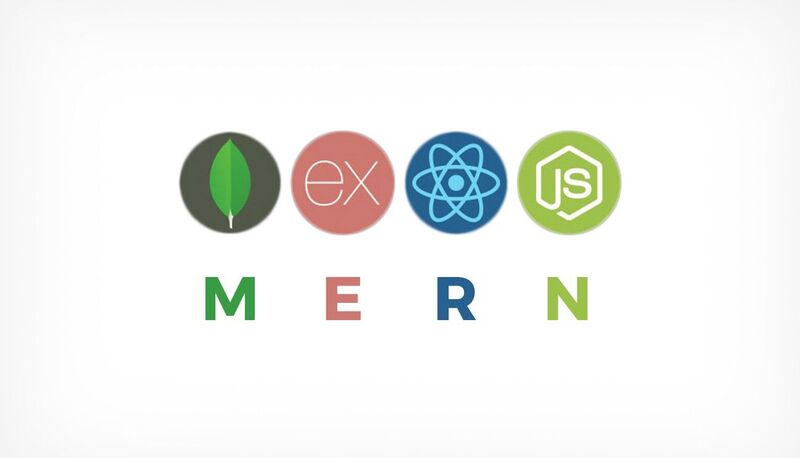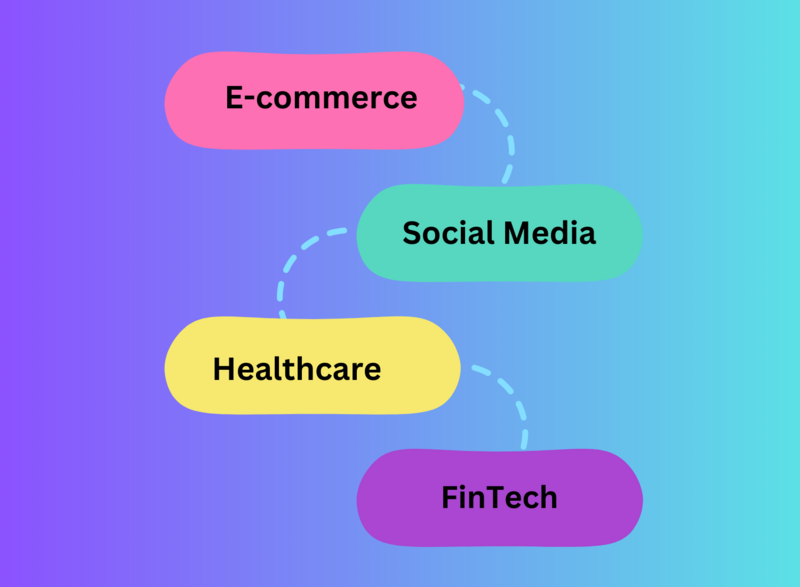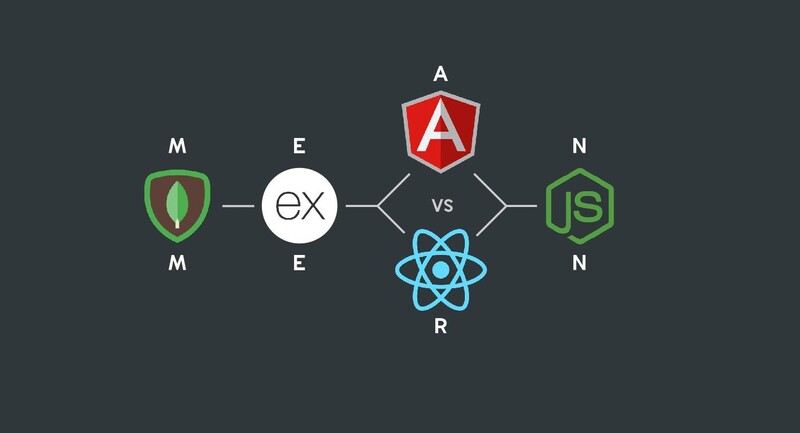Introduction:
In today's digital landscape, businesses constantly seek efficient and dynamic solutions to build robust web applications. One such technology stack that has gained significant popularity is the MERN stack. MERN, an acronym for MongoDB, Express.js, React.js, and Node.js, offers comprehensive tools and frameworks for building modern, scalable, and high-performing web applications. In this blog, we will delve into the MERN stack's versatility, its applications across various industries, its advantages to custom application development, and its overall benefits.

MERN Stack Overview:
The MERN stack is a full-stack JavaScript solution, encompassing both front-end and back-end technologies. Here's a brief overview of each component:
MongoDB: MongoDB is a NoSQL database known for its flexibility and scalability. It stores data in a JSON-like format, making it easy to work with for developers.
Express.js: Express.js is a lightweight and flexible web application framework for Node.js. It simplifies server-side development by providing a robust set of features and middleware.
React.js: React.js is a popular JavaScript library for building user interfaces. Its component-based architecture and virtual DOM make it highly efficient for creating interactive and responsive front-end applications.
Node.js: Node.js is a server-side JavaScript runtime environment. It allows developers to build scalable network applications, handle concurrent requests efficiently, and leverage JavaScript on both the server and client sides.
Applications of MERN Stack across Industries:
The versatility of the MERN stack makes it suitable for a wide range of industries. Here are some unique applications:

E-commerce:
The MERN stack enables the creation of feature-rich e-commerce platforms with real-time inventory management, secure payment gateways, personalized user experiences, and smooth customer interactions.
Social Media:
MERN stack technology powers the development of social media applications by providing real-time data updates, efficient content delivery, personalized feeds, and seamless integration with external APIs.
Healthcare:
The MERN stack is ideal for healthcare applications that require secure data storage, real-time collaboration between doctors and patients, appointment scheduling, and integration with electronic health records (EHR) systems.
FinTech:
The MERN stack's robustness makes it suitable for developing financial applications with features like secure transactions, data analytics, real-time market updates, and personalized financial planning.
Custom Development of Applications with MERN Stack:
The MERN stack offers several advantages for custom application development:
Efficiency:
With a unified JavaScript codebase, developers can seamlessly switch between front-end and back-end development, saving time and effort.
Scalability:
The MERN stack allows applications to scale horizontally by leveraging Node.js's non-blocking I/O and MongoDB's flexible document structure.
Real-time Updates:
MERN stack applications can deliver real-time updates and enhance user experiences using technologies like WebSockets and server-sent events.
Code Reusability:
React.js components can be reused, reducing development time and effort. Additionally, npm (Node Package Manager) provides a vast collection of pre-built modules and libraries that can be easily integrated into projects.
Building application with MERN stack:
Setting up the Development Environment
You must set up your development environment before building web applications with MERN Stack. This involves installing the necessary software and tools on your computer. First, you'll need to install Node.js, which includes the Node Package Manager (npm). Next, you must install MongoDB and set up a local database. Finally, you'll need to install a code editor like Visual Studio Code to write and edit your code. Once you set up your development environment, you're ready to start building your web application.
Building the Back-end with Node.js and Express
The back end of your web application is responsible for handling requests and responses, managing data, and communicating with the front end. In MERN Stack, the back-end is built using Node.js and Express. Node.js is a JavaScript runtime that allows you to run JavaScript code outside a web browser. Express is a web application framework for Node.js that provides tools and features for building web applications. Node.js and Express provide a powerful and flexible back-end for your MERN Stack web application.
Creating the Database with MongoDB
MongoDB is a popular NoSQL database used in MERN Stack development. It stores data in JSON-like documents, making it easy to work with in JavaScript. To create a database with MongoDB, you must first install it on your system and start the MongoDB server. Then, you can use the MongoDB shell or a graphical user interface like MongoDB Compass to create a new database and collections. Once your database is set up, connect it to your Node.js back-end using the MongoDB driver and start storing and retrieving data.
Building the Front-end with React
React is a popular JavaScript library for building user interfaces. It allows you to create reusable UI components and manage the state of your application more efficiently. To make the front end of your MERN Stack application with React, you first need to install it using a package manager like npm or yarn. Then, you can start creating and organizing your components into a component tree. You can also use React Router to handle client-side routing and Redux to manage the global state of your application. Once your front end is ready, you can connect it to your back end using APIs and test and deploy your application.
Benefits of MERN Stack Technology:
Here are some key benefits of working with the MERN stack:
Single Language:
One of the significant advantages of the MERN stack is that it is built entirely using JavaScript. This means that developers can use the same language for both front-end and back-end development, reducing the learning curve and allowing for seamless communication between different application parts. JavaScript is widely known and supported, making finding resources and developers familiar with the language more accessible.
Efficiency and Productivity:
The MERN stack offers a range of tools and frameworks that streamline the development process, resulting in improved efficiency and productivity. With a unified codebase, developers can easily switch between different stack components, reducing context switching and enabling faster development cycles. Additionally, the extensive libraries, packages, and pre-built components available in the JavaScript ecosystem, such as npm, allow developers to leverage existing solutions and focus on building core application logic.
Reusability and Component-Based Architecture:
React.js, a vital component of the MERN stack, follows a component-based architecture. This approach enables code reusability, as developers can create modular and reusable components that can be used across different application parts. This saves development time and ensures consistency and maintainability of the codebase.
Scalability and Performance:
The MERN stack provides scalability options for handling increased traffic and growing user bases. Node.js, with its non-blocking and event-driven architecture, allows applications to handle concurrent requests efficiently. MongoDB, a NoSQL database, offers horizontal scalability by enabling developers to distribute data across multiple servers efficiently. React.js's virtual DOM efficiently updates and renders only the necessary components, optimizing performance and enhancing the user experience.
Real-time Applications:
Real-time functionality has become increasingly important in modern web applications. The MERN stack supports real-time updates and bidirectional communication between the client and the server. WebSockets and server-sent events can be integrated into MERN stack applications to enable real-time notifications, chats, live streaming, and collaborative features.
Community and Support:
The MERN stack has a thriving and active community of developers, providing extensive support, documentation, tutorials, and open-source projects. This community-driven ecosystem ensures that developers access a wealth of resources, problem-solving discussions, and updates, making it easier to troubleshoot issues and stay updated with the latest trends and best practices.
Cost-Effectiveness:
The MERN stack is built on open-source technologies, meaning no licensing costs are associated with using these frameworks and databases. Additionally, the availability of free and open-source libraries and tools further contributes to cost savings in the development process.
Comparing MEAN and MERN Stacks: An In-depth Analysis of the Differences

The MEAN (MongoDB, Express.js, AngularJS, Node.js) and MERN (MongoDB, Express.js, React.js, Node.js) stacks are popular for full-stack JavaScript development. While they share some similarities, there are also notable differences between them. Let's explore the detailed differences between the MEAN and MERN stacks:
Front-end Framework:
- MEAN Stack: The MEAN stack incorporates AngularJS, a widely used front-end JavaScript framework developed by Google. AngularJS follows a Model-View-Controller (MVC) architectural pattern and offers comprehensive features for building dynamic and interactive user interfaces.
- MERN Stack: The MERN stack, on the other hand, utilizes React.js, a powerful JavaScript library maintained by Facebook. React.js follows a component-based architecture and focuses on creating reusable UI components. It uses a virtual DOM for efficient rendering and offers excellent performance and flexibility.
Learning Curve:
- MEAN Stack: AngularJS has a steeper learning curve compared to React.js. It requires developers to understand complex concepts such as dependency injection, directives, and two-way data binding. AngularJS's extensive feature set and opinionated structure may take some time for developers to grasp fully.
- MERN Stack: React.js, with its simplicity and focused approach, has a relatively shallower learning curve. React.js provides a straightforward way to build UI components, and its unidirectional data flow (via props) makes it easier to reason about the application's state.
Community and Ecosystem:
- MEAN Stack: AngularJS has been around for a longer time and has a mature and robust community with extensive resources, documentation, and a wide range of third-party libraries and extensions available.
- MERN Stack: React.js, although newer compared to AngularJS, has gained significant popularity and has a vibrant and rapidly growing community. The React.js ecosystem offers a rich selection of libraries, tools, and community-driven projects.
Rendering:
- MEAN Stack: AngularJS provides server-side rendering (SSR) capabilities, which means the initial rendering of the application can happen on the server. This can be advantageous for search engine optimization (SEO) and improving the initial page load time.
- MERN Stack: React.js primarily focuses on client-side rendering (CSR), where the rendering process occurs in the browser. However, with additional tools like Next.js or Gatsby.js, React.js applications can also incorporate server-side rendering if required.
DOM Manipulation:
- MEAN Stack: AngularJS directly manipulates the Document Object Model (DOM). It keeps track of changes to the DOM and updates the view accordingly. This approach can sometimes impact performance, especially with complex UI updates.
- MERN Stack: React.js uses a virtual DOM, an abstraction of the actual DOM. It efficiently calculates and applies the necessary changes to the virtual DOM and then updates the real DOM, minimizing unnecessary re-renders and enhancing performance.
Flexibility and Reusability:
- MEAN Stack: AngularJS provides a comprehensive framework with conventions and practices. While this can benefit large-scale applications with a consistent structure, it may limit flexibility and reusability for smaller projects or specific use cases.
- MERN Stack: React.js, a library rather than a framework, offers more flexibility and allows developers to choose additional libraries and tools per their project requirements. This flexibility promotes code reusability and enables a more modular and scalable approach.
Ultimately, the choice between the MEAN and MERN stacks depends on project requirements, team expertise, and personal preferences. MEAN Stack with AngularJS is a good fit for large-scale applications with complex UI interactions, while the MERN Stack with React.js offers
Conclusion:
The MERN stack offers a comprehensive, robust solution for developing modern web applications. Its seamless integration of MongoDB, Express.js, React.js, and Node.js provides increased productivity, code reusability, scalability, real-time capabilities, and access to a vibrant developer community. Whether it's building e-commerce platforms, social media applications, healthcare systems, or FinTech solutions, the MERN stack empowers developers to create robust, efficient, and high-performing applications cost-effectively.
Comment
Newsletter to recieve
our latest company updates
Mukesh Ram
Posted OnOct 09,2024Great insights! You've provided a wonderful blog on "MERN Stack Development: 5 Fearful Lagging Practices." I’ve also explored related themes in my recent guide on best practices for full-stack development, which could add further depth to this discussion. Your focus on the potential pitfalls in MERN development highlights the importance of proactive coding strategies to avoid performance bottlenecks. Appreciate your detailed breakdown—definitely a must-read for developers! Looking forward to your thoughts on overcoming these challenges in modern web app development. https://medium.com/@mukesh.ram/mern-stack-development-5-fearful-lagging-practices-512703fc41fc